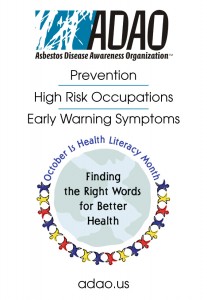Posted on October 2, 2013

October is Health Literacy Month: Do you know the story of Clarence Borel?
Borel testified that at the end of a day working with insulation material containing asbestos his clothes were usually so dusty he could “just barely pick them up without shaking them.” Borel stated: “You just move them just a little and there is going to be dust, and I blowed this dust out of my nostrils by handfuls at the end of the day…
BOREL v. FIBREBOARD PAPER PRODUCTS CORPORATION
Today, asbestos manufacturers are held responsible for exposing their workers to this deadly dust, but this wasn’t always true. In 1973, three years after his death, Clarence Borel won a landmark lawsuit that he began in 1969 when he was already so ill from mesothelioma that he had to testify from his bed. Borel, an industrial insulation worker, sued the corporations that manufactured the asbestos that he worked with, and, for the first time, they were held accountable. Borel didn’t live to benefit from his lawsuit, but it changed the world for the rest of us. Because of Borel, employees who work with asbestos must be warned and must be given protective gear.
October is Health Literacy Month, and at the Asbestos Disease Awareness Organization (ADAO) that means saving lives through prevention. Everyone should know the Irrefutable Facts about how to protect your loved ones from asbestos exposure because the only two ways to end asbestos-caused diseases are prevention and a cure.
This year’s theme is “Be a Health Literacy Hero.” We ask you to be a hero today by reading and sharing the Occupational Safety and Health Administration’s “Asbestos Fact Sheet” about asbestos exposure in the workplace.
This week, we highlight prevention of home, school and workplace exposure to asbestos. Take a few moments today to read the important facts below, then “Be a Health Literacy Hero,” and share this blog with your social networks.
- Always remember that asbestos is a known carcinogen that has not been banned in the US.
- Read and share the National Asbestos Awareness Week 2013 Statement by the U.S. Surgeon General Dr. Regina Benjamin
- Understand where asbestos might be in your home, school, and workplace.
- Never test, remove or even sweep up asbestos yourself! Contact your EPA regional office for a list of licensed asbestos professionals in your area.
If you have any reason for concern, visit www.epa.gov/asbestos/ for more information or call the EPA’s Asbestos Ombudsman at 800-368-5888 or contact the Environmental Information Association, a multidisciplinary non-profit association, for testing and abatement inquires.
For more information about asbestos exposure at home, download our one-page flyer: “Identifying Asbestos in Your Home.”
Our 3-part Health Literacy Month Series will also include the latest high risk occupations information on October 14th and early warning symptoms on October 28th.
In unity,
Linda Reinstein
